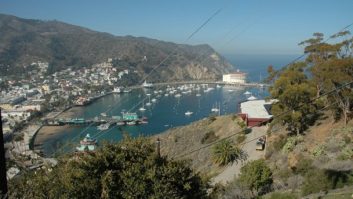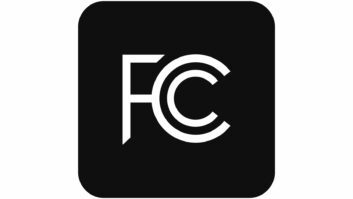In the Oct. 15 issue, I talked about planning for live coverage at the national political conventions. I promised to come back with more from those two weeks and some tips on handling a “super remote” like these.
Our broadcast team added up to 15 total. The technical support crew consisted of me and my colleague Karl Voelker. My responsibilities included all of the audio systems while Karl handled the IT systems. There were also two audio engineers to run mixers for the live broadcast and assist with audio production.

The first of the national conventions began with the Democrats in Denver on August 25. Our plan was to arrive on the 23rd to set up and test equipment preparing for news pre-production to begin on Sunday evening the 24th. Equipment cases were pre-shipped to the site and then delivered to our workspaces by the general services contractor. It was a real time-saver not to have to carry 400 pounds of equipment through security from a remote parking lot at the Pepsi Center with just the two of us — this easily could have taken half a day.
SWEPT AWAY
The immediate goal when we arrived in Denver was to get site access passes, which must be picked up in person. Then we proceeded to the Pepsi Center to check out the sites we would be using for the next six days.
It was a good surprise to see that all our road cases had arrived intact at their proper location on Radio Row. I also checked that all the specified furniture and accessories ordered for our eight-person workspace had arrived at the large air-conditioned tent known as Media Pavilion Two.
We were even more pleased to find that all of the requested telecommunications services, including two ISDNs, two 10 Mbps Internet connections and a total of four business phone lines were in place and working. We got remarkably good service on these crucial broadcast links from Qwest Communications at both the Democratic and Republican conventions. Not only did they provide reliable connections, they staffed a help desk on-site in the Pepsi Center from early in the morning until after midnight each day. This was the best service I have received from a telecommunications provider, ever.
Within an hour or so we knew that we had everything we needed for our broadcasts. Then we had to evacuate the site for the required security sweep. During the sweep, which usually begins at night and runs until the next morning, everyone must leave the building except security personnel. Afterwards security rules become much tighter so it is usually a good idea to get all your equipment in place before.
With the benefit of hindsight, it would have made sense to arrive one day earlier to allow us to complete our final audio and computer setups before the sweep. This would have made the next day much shorter.
We returned on Sunday morning to complete the equipment setup and spent the day resolving a few minor issues with the phone service and furniture at both our broadcast and work sites. We took an hour to show staff the basics of operating the broadcast and computer equipment. I find it helps to take 30 minutes to post notes with important phone numbers at the broadcast site; having a small labeler on site is a good idea.
By the end of the day (and until about midnight) we were feeding production audio back to Boston to be mixed into stories for use on our early Monday news shows.
SECURITY

Sunday afternoon and all is well at our booth in Radio Row before the start of the Republican National Convention. It quickly became apparent that the most difficult aspect of working at the Pepsi Center would be the security arrangements. A number of protest groups had declared publicly their intentions to disrupt the Denver area and potentially make a dangerous assault on convention attendees.
It was necessary to have a pass to get beyond what I dubbed “Checkpoint Charlie,” a portable tent with armed guards about a quarter-mile from the center. The actual security tent at the center included metal detectors and bomb-sniffing dogs for any equipment cases. Then there was a third checkpoint to enter the arena and a fourth checkpoint to gain entrance to the inner seating area. A lot of our time and energy was spent working around these security arrangements.
Oddly, the security procedures seemed to change on a daily basis. At one point on Sunday, guards would not allow any passes and part of our staff was left outside the Pepsi Center making frantic phone calls to our contacts at the DNC. On Monday, all laptop computers had to be opened and turned on while standing in line at the main security tent. Later in the week this requirement was dropped (probably after many laptops were too).
Particularly frustrating was the lack of parking near the Pepsi Center. It is surrounded by dozens of acres of parking, none of which was available. In one lot across the street a group of security officials set up lawn furniture in the shade to watch all of us walk through the open asphalt that had been cordoned off with concrete barriers. Comfortable shoes were a must and woe to anyone who left their pass back at the hotel.
THE BIG SHOW
Just when we began to get comfortable doing live shows from our temporary digs at Pepsi Center we had to prepare for the big curveball: Barack Obama would be making his acceptance speech in the Invesco Field football stadium about two miles away.
We needed to set up yet a third site for live broadcast and work through all the same issues of security, telecommunications, furniture and transportation again.
Invesco Field holds about 80,000 people so it was clear that unless we were inside early to set up it would not be possible to even get in the door due to the overwhelming crowds. I chose to bring a much smaller sports style mixer, the Musicam USA Road Warrior, for our ISDN link to Boston instead of our large Mackie. The extra gear was in separate road cases so that we could keep the Pepsi Center remote site alive and working while we set up Invesco.
One bonus of the large stadium was that my basic security pass allowed me to go inside the stadium bowl. Barack Obama’s speech was the only time during the entire two weeks that I was able to see one of the actual events.
TIME TO MOVE
After the acceptance speech the convention in Denver was basically over. But coming right on its heels was the Republican National Convention in St. Paul.
Karl and I were tasked with striking the Denver site, transporting the equipment and starting the whole process over again.
This is where the road trip comes in. It’s about 900 miles from Denver to St. Paul. We rented a Penske truck, loaded up our cases and drove. We took turns driving the truck through the empty plains between $75 stops to fill the gas tank. Even considering the cost of the truck, we saved about $2,000 compared to overnight shipping from Denver, plus the airline tickets.
By next afternoon, Saturday, we were in St. Paul just in time to pick up a new set of security passes but not in time to make it to the Excel Center before the security sweep closed everything down at 4 p.m.
Happily, security arrangements were much smoother and easier in St. Paul. Other team members flew in before us and helped out with car rentals and equipment dropoff. This gave us extra time to set up our broadcast and work spaces quickly so that pre-production work could begin on Sunday night. Once again the general services contractors and telecommunications providers were extremely helpful and prepared for our arrival so installation could proceed quickly. It also helped that by now we were old hands at doing this setup and we could put it together in our sleep.
WRAP IT UP
The week in St. Paul went by with few hitches. This was a simpler remote because we didn’t have to plan to set up a third site for the acceptance speech by John McCain. In general the crowds were smaller. Although there were some protest marches that turned violent nearby, we fortunately avoided getting caught up in them.
On the final night of the broadcast, we packed everything up again around midnight. Early the next day, we handed the road cases to UPS. Given the size, weight and number of these cases, it made no sense to try to bring them to the airport, especially with the luggage surcharges that are routine now on domestic flights.
I was very ready to head home after that much time on the road and pleased with how successful the entire operation had been.
LAST TIP
As engineers, we tend to focus on equipment and logistics. No one else will take care of these things if we don’t. But it is important to remember that the essential success of a remote depends on the people on the team. Take extra time to make talent and producers comfortable; your effort will help them perform their best. Keep your temper in check at all times even if someone is being unreasonable; the good ones will apologize later. Be the competent center of calm in the middle of the storm and earn everyone’s respect. You will get credit after the remote comes to a successful end.
Do you have a story to tell about a tough remote? Write me at [email protected] and tell me how you handled it.
The author is technical editor for RW Engineering Extra.












